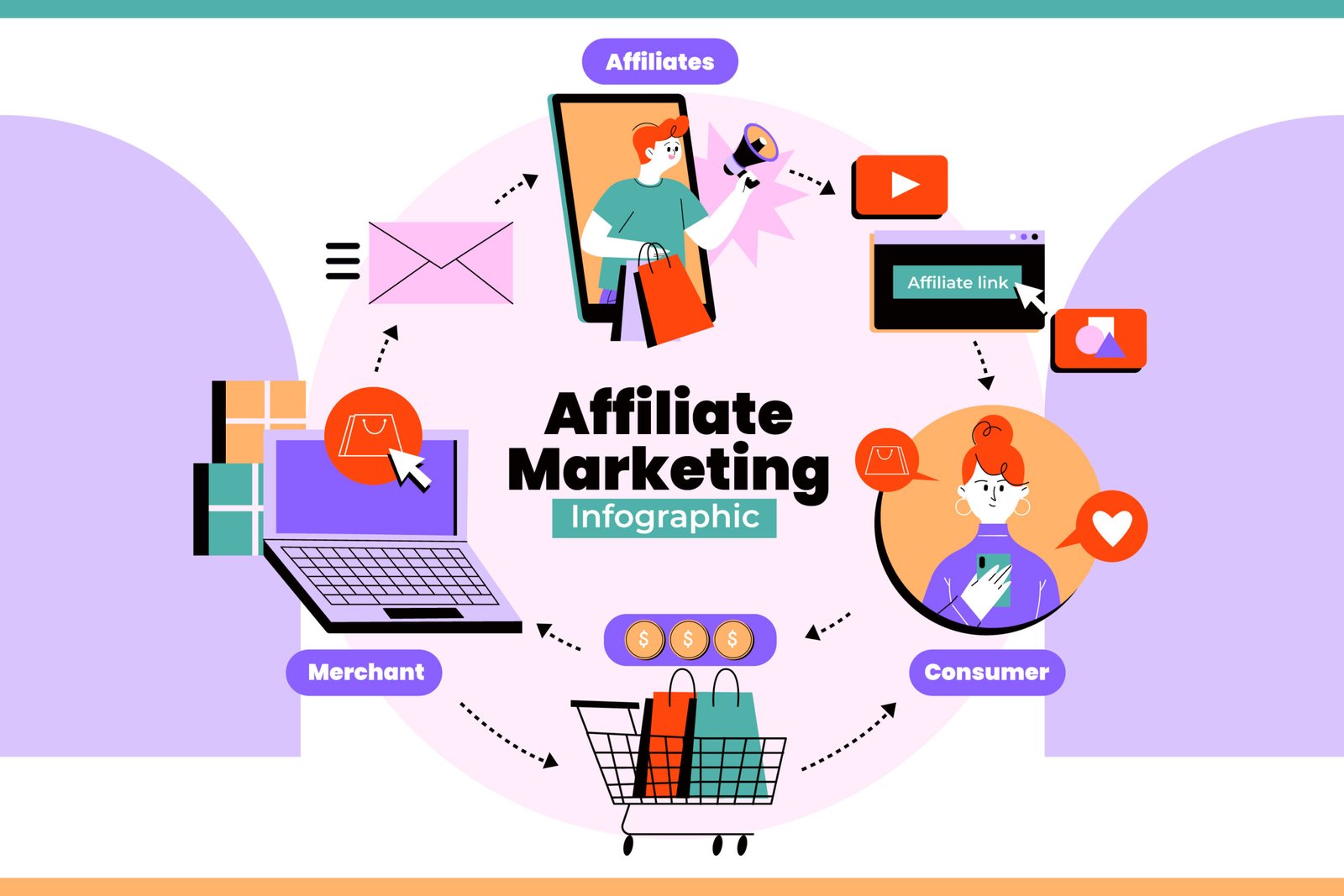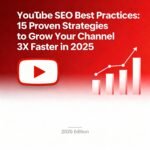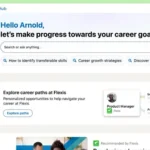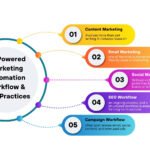Let’s be real, we’re living in the age of performance. In a world where attention spans are short, side hustles are the new 9–5, and digital platforms are the main stage, performance-based income models are no longer fringe, they’re foundational. Whether you’re a creator, a freelancer, or just someone tired of trading time for money, one question keeps coming up in 2025: What is affiliate marketing?
At its core, affiliate marketing is a smart, scalable way to earn passive income by promoting products or services online and earning a commission when someone takes a specific action, usually a purchase through your custom referral link. No warehouses. No customer support headaches. Just you, your content, and your ability to connect people with things they genuinely need.
But this isn’t just internet hype. Affiliate marketing sits at the intersection of digital marketing, performance marketing, and creator monetization. It’s a business model built on results, not promises. And it’s winning big. According to recent data, affiliate marketing is responsible for over 16% of all eCommerce sales in the U.S. alone. That’s more than email. More than display ads. More than your favorite TikTok trend.
So why should you care about “what is affiliate marketing” right now?
Because it’s low-risk, high-reward, and deeply aligned with how the modern internet works. You don’t need to invent a product. You just need to offer solutions, smartly, strategically, and with integrity. Whether you’re a blogger, a YouTuber, a micro-influencer, or someone with a LinkedIn following that listens, affiliate marketing is one of the easiest ways to turn digital attention into income.
Welcome to the blueprint. This isn’t just a guide—it’s your invitation to tap into one of the most powerful revenue streams of the digital era.
What Is Affiliate Marketing?

Strip away the buzzwords and it’s this: a results-driven partnership between a business and a marketer, where you (the affiliate) promote a product or service, and when someone makes a purchase or signs up, downloads, or subscribes, you get paid. That’s it. Clean. Measurable. Performance-based.
Think of it like this: The business handles the product, inventory, and customer support. You handle the trust, the audience, and the influence. In exchange? You earn a slice of the profit every time you drive a conversion. That’s performance marketing in action.
Here’s how it looks in real life:
- Let’s say I sign up for the Amazon Associates program.
- I get a unique affiliate link for a standing desk I personally use and love.
- I write a blog post or film a YouTube video about how it’s boosted my productivity.
- A reader clicks my link, buys the desk—I earn a commission.
The magic? This doesn’t require a warehouse or a customer service team on my end. It’s digital marketing at its most elegant: I focus on content and audience-building, while the brand focuses on fulfillment.
There are thousands of programs, big and small, across every niche you can imagine. From fashion to finance, software to skincare, there’s an affiliate opportunity for practically every interest. And the payouts? They vary. Some offer a flat fee per lead. Others pay out recurring monthly commissions. High-ticket affiliate marketing? That can pay out hundreds per sale.
The key thing to understand is this: affiliate marketing isn’t about pushing random products. It’s about creating meaningful, relevant recommendations that solve real problems and getting rewarded for that value.
In other words: Affiliate marketing is digital trust, monetized.
How Does Affiliate Marketing Work?

If you’re wondering how affiliate marketing works, think of it as a digital relay race—you pass value to your audience, and when they act on it, everyone wins.
Here’s the exact play-by-play:
Join an Affiliate Program
It all starts by finding an affiliate program that aligns with your niche and audience. Some of the most popular platforms in 2025 include:
- Amazon Associates – great for lifestyle, home, tech, and everyday items.
- ClickBank – a go-to for digital products, courses, and info-products.
- Shopify Affiliate Program – ideal for content creators in the eCommerce or small business space.
- Impact, ShareASale, CJ Affiliate – broader networks with access to hundreds of brands.
Once approved, you’re assigned a unique affiliate link—your digital fingerprint for tracking conversions.
Create Content That Naturally Integrates the Offer
Now comes the creative part: you embed those links into content your audience already values. This can be:
- Blog posts (reviews, how-tos, listicles)
- YouTube videos
- Social media posts
- Email newsletters
- Podcasts or even Pinterest pins
The golden rule? Lead with value. Nobody likes a hard sell. But people love a trusted recommendation that solves a real problem.
Drive Conversions & Earn Commissions
When someone clicks your affiliate link and completes the required action (a sale, sign-up, or install), you earn a commission. That commission can be:
- Flat rate – e.g., $20 per lead
- Percentage-based – e.g., 30% of every sale
- Recurring – e.g., monthly payout for every subscription renewal
And with modern tracking tools, you don’t have to manually chase anything. Most affiliate programs use cookies to track users for 7 to 90 days after clicking your link—so even if someone buys later, you still get the reward.
Quick Stat Break:
- Retail businesses account for 44% of all affiliate marketing revenue, reflecting its effectiveness over many traditional channels.
- Affiliate marketing is a top revenue source for 31% of publishers and the most successful customer acquisition channel for 20% of brand marketers.
- Link placements in-content outperform banner ads, demonstrating higher engagement and conversion compared to traditional display ads.
- Affiliate marketers generate around 16% of e‑commerce sales in North America, signaling its growing influence over conventional marketing methods.
That’s the power of performance marketing—you’re not hoping something works, you’re measuring it.
Affiliate marketing works best when paired with long-term strategy and trust-building. It’s not about tricking people into buying. It’s about showing up consistently with digital marketing content that educates, entertains, and converts.
And when done right? It’s one of the most reliable passive income engines available online today.
Why Affiliate Marketing Is Booming And Why It’s A Global Business
Affiliate marketing is not just having a moment, it’s building an empire. And if you’re asking what is affiliate marketing in 2025, it’s not just a smart question—it’s a strategic one.
Why? Because this model works for everyone involved.
For Businesses: It’s All About Results
Traditional ads? Expensive. Hit-or-miss. But affiliate marketing? It’s performance-based. That means brands only pay when there’s a real result—like a sale, lead, or signup. No wasted spend. No guesswork.
Demand Sage (2025) reports that “81% of marketers use affiliate marketing to raise brand recognition,” and 84% of publishers use it too. That’s because it offers:
- Scalable reach through content creators and influencers
- Built-in trust via personal endorsements
- Low customer acquisition cost compared to paid search or social
For Affiliates Like Me: It’s Flexible, Scalable, and Sustainable
You don’t need to create a product. You don’t need to ship or support anything. Your job? Connect people to solutions through valuable content and relevant recommendations.
Some of the biggest advantages of affiliate marketing from a creator’s perspective:
- Low startup costs – A blog, a niche, and a strategy. That’s it.
- No customer service – The merchant handles all fulfillment and support.
- Unlimited earning potential – As your platform grows, so does your passive income.
- Geographic freedom – Work from anywhere, anytime.
The Creator Economy + Affiliate Marketing = A Perfect Storm
We’re in the middle of a shift. People trust people, not ads. And with millions of creators now monetizing their expertise across blogs, YouTube, TikTok, and podcasts, affiliate marketing is the fuel behind their revenue engines.
Even micro-influencers are cashing in: according to Shopify’s 2025 Affiliate Marketing Guide, influencers with just 1,000–10,000 followers see conversion rates as high as 6.2% when using tailored affiliate offers.
Bottom Line:
The boom is real—and it’s only getting louder. Whether you’re a seasoned content creator or a side hustler dipping your toes into digital marketing, affiliate marketing gives you a powerful, low-risk path to build passive income by simply being helpful.
In a world where performance matters more than polish, this model is built to last.
3 Different Types of Affiliate Marketing And Which One Pays Best

Not all affiliate marketing is created equal. And if you’re serious about making it work, it’s crucial to understand the three core types—because the difference between a few clicks and a scalable income stream? It’s often tied to how you position yourself.
So when someone asks what is affiliate marketing, the real answer depends on how personally involved you are in what you’re promoting.
1. Unattached Affiliate Marketing
This is the most hands-off model.
- You don’t use the product.
- You don’t have a personal brand or niche presence.
- You’re essentially running ads or creating generic content to drive clicks.
Think: pay-per-click ads, automated blog posts, or landing pages with affiliate links and no face behind them.
Pros: Easy to start, low effort
Cons: Lower trust, lower conversion, short-term results
It works best in volume-heavy, CPA marketing campaigns especially if you’re skilled with paid ads and analytics.
2. Related Affiliate Marketing
You’re in the niche, you have some expertise, and people know you talk about the topic, but you haven’t necessarily used the product.
For example, if you run a fitness blog and promote a meal plan app you haven’t personally tried, that’s a related approach.
Pros: Leverages existing audience and niche authority
Cons: May feel impersonal if you’re not transparent about usage
This type bridges the gap, it’s common in digital marketing blogs, YouTube how-to videos, and listicle content.
3. Involved Affiliate Marketing
This is the gold standard and usually the most profitable.
You use the product. You genuinely love it. You endorse it not because you’re paid, but because it works.
You might say:
“I’ve used [this tool] for the last year. It cut my workflow in half. Here’s a screenshot of my dashboard and my results.”
This is the kind of authenticity that builds trust, clicks, and commissions.
Pros: Higher conversions, stronger brand, long-term credibility
Cons: Requires real experience and time investment
And guess what? Involved affiliates often unlock higher commission tiers, exclusive partnerships, and even recurring deals with brands. That’s what makes this strategy a core pillar of high ticket affiliate marketing.
Which Should You Choose?
If you want quick wins and know your way around paid ads, unattached might work. But if you’re building a brand, audience, or long-term revenue stream, involved affiliate marketing is where the real money and impact is.
Remember: The more personally aligned you are with what you promote, the more trust you build. And in affiliate marketing, trust is the ultimate currency.
Affiliate Marketing for Beginners: First Steps to Get Started
If you’re brand new and thinking, “Okay, but how do I actually begin?”—this is where we map out your affiliate marketing game plan from scratch. Because knowing what is affiliate marketing is just the start. Turning that into consistent, scalable passive income? That’s the real goal.
Choose Your Niche
Start with what you know—or what you’re excited to learn. The tighter your niche, the easier it is to speak directly to a problem people are actively searching to solve.
Great beginner-friendly niches in 2025:
- Personal finance (budgeting tools, investing apps)
- Health & fitness (supplements, wearables, home workouts)
- Tech & gadgets (apps, SaaS tools, creator gear)
- Digital marketing (email tools, SEO software, landing page builders)
- Lifestyle & productivity (journals, online courses, work-from-home gear)
TIP: Use tools like KeySearch or MailDrip’s keyword planner to find long-tail affiliate marketing keywords with low competition but high intent.
Pick the Right Affiliate Programs
Not all affiliate programs are beginner-friendly. Start with platforms that offer:
- Easy approval (no huge audience required)
- Solid support materials (pre-made banners, copy, data)
- Reasonable payout thresholds
Recommended starter-friendly programs:
- Amazon Associates – Massive product catalog, trusted brand.
- ShareASale – Diverse merchants across niches.
- Impact – Streamlined application process.
- GetResponse Affiliate Program – Recurring commissions on email marketing plans.
- ConvertKit – Ideal for creator-focused platforms.
Look for programs with at least 5–30% commission rates and recurring payment structures if possible.
Set Up Your Platform
You need somewhere to build trust and deliver content—this could be:
- A WordPress blog with SEO plugins like RankMath
- A YouTube channel with affiliate links in the description
- A newsletter built on ConvertKit or GetResponse
- A Pinterest board driving traffic to blog posts or lead magnets
Choose the format you’re most comfortable with, but don’t rely solely on social media. Platforms change. Algorithms shift. Own your space with a website or email list.
Create High-Value Content
Content is where affiliate marketing lives and breathes. It’s how you answer questions, rank on Google, build trust—and ultimately earn.
Focus on:
- Tutorials: How to use the product
- Reviews: Honest pros and cons
- Comparisons: “Tool A vs Tool B”
- Listicles: “Top 5 Affiliate Programs for Beginners”
- Case Studies: Your personal results
Always blend affiliate keywords naturally. Don’t keyword-stuff. Instead, teach first, recommend second.
Track, Optimize, and Scale
Use link tracking tools like PrettyLinks or ThirstyAffiliates to monitor what’s working. Check your analytics. Double down on high-performing content. Test headlines. Refine CTAs. Add email opt-ins to capture leads.
Affiliate marketing isn’t static. It’s iterative. The more data you collect, the sharper your strategy becomes.
Tip: Join Affiliate Communities
Don’t go it alone. Join Facebook groups, Reddit forums, and Discords focused on affiliate marketing. You’ll learn faster, stay motivated, and avoid common beginner mistakes.
Whether you’re writing your first blog post or posting your first affiliate link on TikTok, the key is to start imperfectly and stay consistent. Affiliate marketing rewards those who play the long game with integrity and strategy.
5 Must-Have Tools to Crush Affiliate Marketing in 2025
If affiliate marketing is a game of leverage, tools are your unfair advantage. From tracking to content creation to email automation, the right stack can save you hours and make you money.
Here’s your curated 2025-ready affiliate marketing toolkit—built for beginners, but scalable for pros.
1. Content Creation Tools
You need content that ranks, converts, and builds trust.
- Jasper.ai or ChatGPT – Draft outlines, descriptions, hooks, or ad copy fast
- Grammarly – Edit like a pro without hiring one
- Canva Pro – Design social graphics, Pinterest pins, and thumbnails on the fly
- Lumen5 – Turn blog posts into quick promo videos for YouTube or Reels
TIP: Use Canva templates to create affiliate-rich lead magnets like checklists or free guides. These convert like wildfire on email sign-ups.
2. Link Management & Tracking
Your affiliate links are your income stream. Don’t leave them messy or untracked.
- Pretty Links (WordPress) – Cloak links, add branded slugs, and see click reports
- ThirstyAffiliates – Advanced tracking and link categorization
- Bitly – Free, easy-to-share short links for social platforms
Want to know which blog post drives the most conversions? These tools show you.
3. SEO & Research Tools
Affiliate marketing and SEO go hand-in-hand. If you can rank, you can bank.
- KeySearch – Low-cost, beginner-friendly keyword research
- Ubersuggest – Keyword ideas, competition level, and domain audits
- AnswerThePublic – Great for long-tail questions that double as blog topics
- SurferSEO – Optimize content to rank higher in search results
TIP: Pair SurferSEO with Jasper or ChatGPT to generate optimized blog drafts in minutes.
4. Affiliate Network Platforms
These are where you’ll find affiliate programs to join and manage.
- Impact – Used by major brands like Shopify and Canva
- ShareASale – Easy access to diverse brands across industries
- CJ Affiliate (formerly Commission Junction) – Trusted by big eCommerce players
- ClickBank – Perfect for info products and high-ticket offers
- PartnerStack – Tech-forward affiliate hub for SaaS and tools
Each network has different niches and payout styles. Don’t just join—explore what fits your niche best.
5. Email Marketing Tools
Your email list is your money machine. Don’t sleep on it.
- ConvertKit – Made for creators, beautiful automations, and affiliate-friendly
- GetResponse – Affordable and packed with landing pages + webinars
- MailerLite – Simple, intuitive, and great for beginners
- Beehiiv – Clean interface, built-in monetization for newsletters
Tip: Build a simple funnel—freebie ➝ email list ➝ affiliate offer—and automate the rest.
Bonus: Analytics & Optimization
To scale, you need data. Period.
- Google Analytics 4 – Know who’s visiting and what they’re clicking
- Hotjar – See heatmaps and scroll behavior on your affiliate landing pages
- Microsoft Clarity – Free alternative to Hotjar with session recordings
The faster you learn what works, the faster you grow.
The beauty of affiliate marketing in 2025? You don’t need a massive team—just the right tools, the right mindset, and consistency. The rest can be automated, tracked, optimized, and scaled.
15 Top Affiliate Programs in 2025: High Payouts + Recurring Commissions
You can create all the content in the world—but if your affiliate programs pay pennies or ghost on payouts, you’re wasting energy. In 2025, the best affiliate programs don’t just pay well… they pay repeatedly.
Here’s a breakdown of top-performing affiliate programs this year—sorted by reliability, recurring commissions, and niche-fit.
Best SaaS Affiliate Programs
SaaS tools are the backbone of affiliate marketing. They’re sticky, subscription-based, and often offer recurring payouts.
| Program | Commission | Recurring? | Notes |
| ConvertKit | 30% lifetime | Built for creators, ideal for content-heavy niches | |
| GetResponse | 33% recurring or $100 one-time | Great for email and automation tutorials | |
| Beehiiv | 50% recurring | Newsletter-focused, perfect for creators/influencers | |
| SurferSEO | 25% recurring | Top pick for SEO bloggers | |
| Canva Pro | Up to $36 per signup | Everyone needs visuals, high conversion rates | |
| ClickFunnels 2.0 | 30–40% | High-ticket, funnel-based sales systems |
Insight: Always read the terms—some programs like Canva require conversion within 30 days for payouts.
Best eCommerce + Product-Based Programs
If you’re reviewing physical or digital products, these are your go-to:
| Program | Commission | Recurring? | Niche |
| Amazon Associates | 1–10% | Giant inventory, low rates, short cookie window (24h) | |
| Impact Radius (e.g., Shopify) | Varies | Some | Shopify offers $150–$200 per sale |
| Awin | Varies | Great for fashion, lifestyle, travel brands | |
| Creative Market | 15% | Great for designers, bloggers, and digital marketers | |
| Bluehost | $65–$130 | Still strong in the blogging/web hosting space |
Bonus: Promote Amazon with content upgrades—like blog reviews or comparison charts—to increase conversions.
Best Info Product & Course Affiliate Programs
Knowledge sells—especially when packaged well. These platforms let you monetize digital education.
| Program | Commission | Recurring? | Notes |
| Teachable | 30% | Ideal for creators in education/business | |
| Podia | 30% recurring | Courses, digital downloads, memberships | |
| Skillshare | $7–$10 per trial | Works well with YouTube tutorials | |
| Coursera | 10–45% | Professional/academic audience |
Pro Play: Pair course reviews with content like “Top 5 Courses for Digital Marketers” or “Best Teachable Alternatives.”
How to Choose the Right Affiliate Program
Ask these before joining:
- Is it relevant to my audience’s real problem?
- Can I personally vouch for the product or service?
- Is the commission structure fair (recurring > one-time)?
- How long is the cookie duration?
- Is there a minimum payout threshold or payout delay?
Don’t chase shiny commissions. Focus on alignment and longevity. Your credibility = your currency.
Real Affiliate Marketing Examples That Actually Work

Theory is cute—but what actually works? Let’s get into three real-world affiliate marketing strategies that generate passive income consistently in 2025. These aren’t hypothetical fluff; they’re proven, practical, and beginner-friendly.
Example 1: SEO-Driven Blog with Monetized Tutorials
Niche: Email marketing for solopreneurs
Platform: WordPress + ConvertKit + SurferSEO
Strategy:
- Create high-intent blog posts like “Best Email Marketing Tools for Coaches” or “ConvertKit vs Mailchimp: Which One’s Better in 2025?”
- Optimize using SurferSEO or RankMath
- Insert affiliate links naturally inside tutorials, comparisons, and call-to-actions
- Collect emails using a freebie (like a “Welcome Email Template”)
- Funnel readers into a ConvertKit affiliate pitch via email series
Why it works: It targets readers already searching for solutions—and educates them before pitching.
Example 2: Instagram Reels + Link in Bio Funnel
Niche: Skincare influencer
Platform: Instagram + Linktree or Stan Store + Amazon Associates
Strategy:
- Film Reels like “My 5-Minute Morning Routine for Acne-Free Skin”
- Tag all products subtly in captions
- Use Linktree or Stan Store to house affiliate links
- Promote weekly skincare tips via Stories and save to Highlights
- Occasionally link to longer-form product review blogs or videos for deeper engagement
Why it works: It builds visual trust and blends into content naturally—ideal for lifestyle and beauty creators.
Example 3: YouTube Tutorial Channel with Deep Affiliate Integration
Niche: AI Tools & Productivity
Platform: YouTube + Beehiiv + ClickFunnels
Strategy:
- Record videos like “Top 3 AI Tools for Freelancers in 2025”
- Include affiliate links in the description and pinned comment
- Offer a free guide (“10 AI Prompts to Save You 5 Hours a Week”) in exchange for email
- Use Beehiiv to follow up weekly with more tips and monetized suggestions
- Funnel subscribers into a ClickFunnels affiliate course or template
Why it works: Long-form video = high trust. Viewers spend time with you, which boosts conversions.
Key Takeaways Across All 3:
- Trust trumps traffic — A smaller, loyal audience converts more than a massive cold one.
- Use lead magnets — Offer something valuable upfront to build your list.
- Blend value + pitch — Don’t hard-sell; educate, guide, and then recommend.
- Automate the backend — Let tools do the heavy lifting (email, funneling, tracking).
You don’t need to go viral. You just need to solve a problem and recommend a solution people can trust. That’s affiliate marketing, the smart way.
5 Common Affiliate Marketing Mistakes and How to Avoid Them
Affiliate marketing looks easy—but one wrong move can cost you clicks, credibility, and cash. If you’re serious about building a sustainable passive income stream, you need to avoid these rookie traps that even “pros” fall into in 2025.
1. Promoting Products You Don’t Use (or Trust)
Why it’s bad:
If you’re recommending something you’ve never tried—or worse, don’t even believe in—your audience will sense it. And when trust dies, so does your affiliate revenue.
Fix it:
Only promote tools, services, or products you genuinely believe in. If you haven’t used it personally, get access, demo it, or study deep user reviews before endorsing.
TIP: Add screenshots, tutorials, or case studies to prove you’re the real deal.
2. Spamming Links Without Context
Why it’s bad:
Dropping affiliate links without explaining why someone should click = crickets. No one likes a random link dump.
Fix it:
Frame every link with value and purpose. Explain how it solves a specific problem. Use comparison tables, product use cases, and FAQs to educate before you pitch.
Remember: Context converts. Blind links don’t.
3. Ignoring SEO or Search Intent
Why it’s bad:
If no one’s searching for what you’re writing or posting about, your content is invisible—and so are your commissions.
Fix it:
Do proper keyword research. Target long-tail search terms like “best free AI writing tools 2025” or “ConvertKit vs Mailchimp for beginners.” Answer questions people are actually asking.
Use tools like:
- Ubersuggest
- AnswerThePublic
- Google’s “People Also Ask”
4. Not Tracking or Optimizing Performance
Why it’s bad:
Without tracking clicks and conversions, you’re flying blind. You won’t know what’s working—or what’s leaking income.
Fix it:
Use UTM parameters, track with affiliate dashboards, and analyze data weekly. Test headlines, link placement, and CTAs.
Tools to try:
- Pretty Links
- ThirstyAffiliates
- Google Analytics
- Your affiliate program’s native tracking
5. Skipping Disclosures (Yes, It’s the Law)
Why it’s bad:
Failure to disclose affiliate links isn’t just shady—it’s illegal in most regions. It kills credibility and could lead to penalties.
Fix it:
Add a short disclaimer like:
“This post contains affiliate links, which means I may earn a commission at no extra cost to you. I only recommend what I use and love.”
Bonus: Being transparent builds trust and boosts conversions long-term.
Final Rule? Play the Long Game
Affiliate marketing is a marathon—not a flash sale. Show up consistently, serve your audience first, and watch the rewards stack. Most people quit too early. Don’t.
How to Start Affiliate Marketing in 2025? 5 Step-by-Step Beginner Blueprint
Overwhelmed by all the strategies and platforms? Don’t be. Here’s your zero-to-launch roadmap for starting affiliate marketing from scratch—without guesswork, hype, or tech headaches.
1. Pick a Niche That Pays (and Fits You)
Don’t chase trends—chase problems you can help solve. That’s where the money is.
Look for niches where:
- People are actively looking for solutions (e.g., “best CRM for freelancers”)
- There are affiliate programs with recurring or high-ticket payouts
- You have interest, experience, or access to a relevant audience
2025 niche ideas:
- AI tools for small business
- Remote productivity gear
- Sustainable fashion
- Personal finance for Gen Z
- Health tech gadgets
2. Join the Right Affiliate Programs
Once you’ve picked a niche, find affiliate programs that match your content goals.
Two main options:
- Affiliate networks like ShareASale, Impact, CJ, and PartnerStack (lots of offers in one place)
- Direct programs from brands like ConvertKit, Hostinger, Notion, etc.
Check for:
- Commission rate (% or flat)
- Cookie duration (30 days or longer is solid)
- Payment methods and frequency
- Tracking dashboard and support
Example: Want to promote a newsletter platform? Join Beehiiv or ConvertKit’s affiliate programs directly.
3. Build a Content Platform (Don’t Overthink It)
You need a space to educate and recommend—aka your conversion engine.
Pick one to start with:
- Blog/Website – Best for SEO and long-term search traffic
- YouTube Channel – Great for visual demos, tutorials, and reviews
- Instagram or TikTok – Powerful for lifestyle and product-led storytelling
- Email Newsletter – Best for nurturing your audience and re-engaging over time
Tip: Pair your content with an email opt-in from Day 1. Build your list. Own your audience.
4. Create Value-Driven Content with Strategic Links
Forget hard selling. Your job is to educate first, monetize second.
Content ideas that convert:
- Comparison posts (X vs Y)
- How-to guides
- Listicles (“Top 5 Tools for Freelancers in 2025”)
- Product demos or tutorials
- Personal case studies
Embed your affiliate links:
- Inside the body (with context)
- Below product recommendations
- In buttons or calls-to-action
- In your email footer
Pro move: Use Pretty Links to shorten and brand your affiliate URLs.
5. Promote, Track, and Optimize
Even the best content needs eyeballs. Share it, test it, and scale what works.
Promotion channels:
- Pinterest (great for blog traffic)
- Facebook Groups or niche communities
- Twitter/X threads and link roundups
- Weekly newsletters
- Collaborations with other creators
What to track:
- Clicks (Are people engaging?)
- Conversions (Are they buying?)
- ROI (What content drives the most money?)
Tweak, repeat, and double down on winners.
Affiliate Launch Kit
| Step | What to Do | Tools to Use |
| 1 | Pick a profitable niche | Google Trends, Ubersuggest |
| 2 | Join affiliate programs | ShareASale, Impact, ConvertKit |
| 3 | Choose a platform | WordPress, YouTube, Beehiiv |
| 4 | Create content with links | SurferSEO, Canva, Grammarly |
| 5 | Promote & optimize | Pinterest, Email, Pretty Links |
This blueprint doesn’t require coding, a huge budget, or a massive audience. Just consistency, clarity, and commitment.
Is Affiliate Marketing Worth It in 2025? My Honest Opinion
Here’s the honest answer:
Yes, affiliate marketing is absolutely worth it in 2025, but only if you treat it like a business, not a side hustle lottery ticket.
Let’s break down the reality.
Why It IS Worth It
1. Low Startup Cost, High Scalability
You can start with a domain, a laptop, and Wi-Fi. That’s it. No inventory. No customer support. No tech headaches. Once your content ranks or your email funnel is live, your links keep working 24/7—earning while you sleep.
2. Performance-Based = You Control the Outcome
Unlike a job with capped pay, affiliate marketing rewards effort, creativity, and smart execution. The more you optimize your strategy, the more you can earn.
3. Multiple Passive Income Streams
Join multiple programs across tools, platforms, or niches. If one dries up, the others keep flowing. You’re not reliant on a single product or platform.
4. Remote, Flexible, and Creator-Friendly
You can run everything from your phone. Create a blog post at home. Publish a TikTok at a beach café. Your affiliate empire can grow from literally anywhere.
But Here’s the Catch…
Affiliate marketing in 2025 is not easy money.
You’ll need to:
- Invest time upfront: Quality content, keyword research, testing links
- Build trust with your audience: No one buys from random strangers
- Adapt to changes: Algorithms, affiliate program terms, new tools
- Be patient: It could take weeks or months to see results—but once it kicks in, it compounds
Think of it like planting seeds—not picking fruit on Day 1.
Reality Check:
| Expectation | Reality |
| “I’ll get rich in 30 days.” | It’s a long game—consistent work compounds. |
| “I just need to post links.” | You need a real content strategy. |
| “No need to learn SEO/email/video.” | Learn one distribution channel well and expand from there. |
| “I’ll promote anything that pays.” | Your audience only clicks if they trust you. |
Conclusion: Affiliate Marketing Can Change Your Life
If you’re willing to:
- Learn the strategy
- Show up consistently
- Serve your audience before selling
- Focus on long-term value…
Then yes—affiliate marketing in 2025 is not just worth it.
It’s one of the most powerful digital income streams available today.
Now that you’ve got the full picture—from what affiliate marketing is to how to win at it in 2025—it’s your move.
Ready to stop scrolling and start earning?
Start with one affiliate program. Publish one value-packed piece of content. Track it. Learn. Improve.
That’s how real creators build passive income in this era.
Frequently Asked Questions About Affiliate Marketing
What exactly is affiliate marketing?
Affiliate marketing is a performance-based income model where you promote someone else’s product or service and earn a commission every time someone buys through your unique affiliate link. Think of it like digital word-of-mouth—except you get paid for every successful referral.
How do affiliate marketers make money?
Affiliate marketers earn money when someone clicks on their affiliate link and completes a desired action—usually a purchase or signup. Commissions vary based on the product, program, and payout structure (percentage or flat fee).
Is affiliate marketing passive income?
Yes—partially. Once your content is published and links are live, they can keep generating income for months or years. But you’ll still need to update content, test new offers, and drive traffic to keep earnings flowing. It’s not “set it and forget it”—but it is scalable.
How much can a beginner earn from affiliate marketing?
Beginners may earn between $50 to $500/month in the first few months if they’re consistent. With time, strategy, and traffic, many affiliate marketers scale to $1,000–$10,000+/month. There’s no cap, but there’s no magic either—you’ll need strategy and patience.
What’s the best platform for affiliate marketing in 2025?
There’s no one-size-fits-all.
- Blog/Website for long-term SEO traffic
- YouTube for product reviews and tutorials
- Email Newsletter for trust-building and retargeting
- Social Media for reach and trend-based content
Choose the one that fits your strength and audience.
Do I need a website to start affiliate marketing?
No—but it helps. You can start on platforms like YouTube, Instagram, TikTok, or Medium. However, owning a website gives you control, SEO benefits, and a long-term content base that doesn’t rely on algorithm changes.
Is affiliate marketing legal and ethical?
100% yes—if you disclose properly.
Always use affiliate disclosures (e.g., “I may earn a small commission”) and promote products you genuinely believe in. Transparency builds trust—and trust drives clicks.
Can I do affiliate marketing without showing my face?
Yes! You can run blogs, email newsletters, or faceless YouTube channels. Many successful affiliate marketers build income streams behind the scenes using written content, voiceovers, or animation.
What tools do I need to start affiliate marketing?
To get started:
- A website or content platform (e.g., WordPress, YouTube)
- Affiliate links (via programs or networks)
- Link tracking tools (e.g., Pretty Links, Thirsty Affiliates)
- SEO/Content tools (e.g., SurferSEO, Canva, Grammarly)
- Optional: Email platform (like Beehiiv or ConvertKit)
Is affiliate marketing saturated in 2025?
Not if you niche down and deliver real value.
The “spammy” days are gone. What works now is niche expertise, authentic content, and trust. There are still massive untapped opportunities in emerging markets, new SaaS tools, and underserved audiences.













